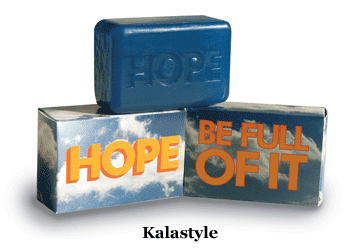|
 Retailers have been hit hard by the recession. Recent statistics speak volumes: About 148,000 stores closed their doors permanently in 2008, and 73,000 more were projected to close in the first half in 2009, according to the International Council of Shopping Centers in New York. That’s a lot of dreams down the drain! Retailers have been hit hard by the recession. Recent statistics speak volumes: About 148,000 stores closed their doors permanently in 2008, and 73,000 more were projected to close in the first half in 2009, according to the International Council of Shopping Centers in New York. That’s a lot of dreams down the drain!
Stationery Trends sent an e-blast inquiring what approaches its retail readership were taking to combat the recession. Many respondents, like Hanna Shaner of Inscriptions in Cherry Hills Village, Colo., attack the problem on many fronts. “We are doing everything! E-mailing clients with discounts as they’re available from vendors; more customer service; free addressing on in-house printing; advertising and just trying to be more responsive and creative. It is also very important to be sensitive to cost, and to offer a variety of prices for clients.”
Retail, Reinterpreted
Many venues have reinterpreted their entire approach. Gayle O’Donnell, All About Weddings, Seattle, and ST Editorial Advisory Board member, responded to budget-conscious, DIY brides in her area by rethinking her store layout. “We added a DIY department featuring Marsupial and Waste Not Paper. We also feature imprintables, mostly for showers and rehearsal dinners, and we’ve begun offering in-house printing for any paper (here). We also installed a fixture with tools for brides to use for their creations. Brides have responded positively, and everyone is amazed and complimentary.”
 Georgia Bates of A Stationery Shoppe in Sylvania, Ohio, made some changes after realizing foot traffic was probably not going to return any time soon. First, “I changed the storefront to appointment only, and cut my expenses by 75 percent by getting rid of my big ‘overhead suite’ expense, and started a home office. I changed my business phone number to my cell and now I am home, still getting orders without the overhead.” Georgia Bates of A Stationery Shoppe in Sylvania, Ohio, made some changes after realizing foot traffic was probably not going to return any time soon. First, “I changed the storefront to appointment only, and cut my expenses by 75 percent by getting rid of my big ‘overhead suite’ expense, and started a home office. I changed my business phone number to my cell and now I am home, still getting orders without the overhead.”
Customer Spotlight
Focus on those who keep you afloat by offering them “service, service, service,” suggested Susan Hyre of Susan Hyre Paperworks, Alexandria, Va. “Many of my clients are disgruntled customers from somewhere else.”
An extra amenity can become new business. Just ask Lydia Lynch of Paper Presence, Beacon, N.Y., who offers free gift-wrapping on all purchases. “I select from about a dozen wrapping papers and use fabric ribbon and an embellishment for a high-end look. While I wrap, customers frequently find more items to buy or wrap. I usually enclose a business card for the recipient, resulting in some new customers. Customers (also) bring me gifts purchased elsewhere, which they pay me to wrap.”
Karen Myers of Karen’s Hallmark Shop, Altadena, Calif., has seen about a 7 percent decrease in 2009. “With sales being so slow, we’re having to really take a look at what our store is about.”
So she’s started a customer request list. “(We) write down EVERYTHING (they) request. This lets me know what we might consider carrying.”
It’s also about going the extra mile, she added. “We’ve called different stores to find something a customer is looking for, I’ve delivered items, we’ve opened the doors after they were locked because a gentleman needed a card for his mother. These things really matter!”
“I’ve renewed my commitment to customer service, whether the customer is buying a $4 greeting card or a $1,500 wedding (trousseau),” echoed Jenni Undis of Lunalux, Minneapolis, Minn. “Our clients are choosing to spend their hard-earned money at our shop, so I want each to feel that they are a high priority, even if I’m juggling a dozen projects. I stay in close contact via phone and e-mail, and I ALWAYS send a hand-written thank-you (afterward).”
Myers also monitors customer feedback through a consumer satisfaction program. A $2-off coupon is randomly printed on receipts, inviting customers to take a phone survey. “We access (it) online to see our score on product selection, customer service, store cleanliness, etc. It’s a great help; we share the audio comments at meetings and discuss what changes we should make.”
Merchandising & Marketing
Repeatedly, retailers spoke of making the most exciting displays they can. “I use my windows to best advantage (with) attention-getting seasonal displays and continue the theme inside,” described Lynch. “Many customers look forward to seeing what I come up with. It doesn’t cost much and it usually brings an increase in walk-ins and purchases.”
Merchandising can be amazing camouflage, noted Elizabeth Howard, the Cordial Cricket, Chester, Va. “We’ve purchased much less inventory this year, simply because not as much is moving out. (So) we move (it) around and create new displays on a very frequent basis. It tricks customers into thinking that we’re bringing in new things; it works tremendously well.”
Maintaining a customer e-mail list can reap rewards, emphasized Lynch. “I (e-mail) seasonal reminders, always with a brief, personal, positive note. I attach a flier about special sales, events or products/services. Some customers (say) they’re glad I remind them about upcoming holidays. Within a week or so, customers I haven’t seen in a while stop in, usually to buy.”
Expense Approaches
Many respondents decrease costs with modified store and employee hours. “We have cut back employees’ hours, and we have also decreased our hours by three hours a week; it makes a difference,” Myers said. “So far, customers haven’t said anything. My husband and I are on the sales floor more. If someone needs to go home early or calls in sick, we don’t call someone else, we take the shift ourselves.”
Amending buying approaches were frequently cited. “We buy what will fit on shelves, nothing more!” commented Myers. “We can’t give the image we are going out of business, so the racks on display look fresh and filled.”
“We keep something for all occasions in stock, and order what our customers need if they buy an amount to make shipping and ordering worthwhile,” stated Barbara Wicker, The Station House, Coleyville, Texas, and ST Editorial Advisory Board member. “Some vendors are easing reorder amounts; this is a huge help.”
Many have also reexamined shipping costs, like Allison Witkowski, The Satin Bow, Flemington, N.J. “I have been researching new suppliers that provide low-cost or free shipping and are closer to my home base. On some orders (shipping) can be 10 percent if not more; especially (with) heavy supplies such as paper.”
Lynch takes an all-around, cost-cutting approach. “I am exercising more caution with replenishing product, waiting longer to order seasonal items and being more selective. I order smaller quantities and work with reps to get discounts, free freight or extended terms.”
Sales and Such
Some stationers, like Anne Renner of Annabelle Ink, Chattanooga, Tenn., find that a modified price structure exudes the feel of a bargain. “We build the cost of (in-house) printing into the price of each card; then the customer thinks they are getting free printing. An average Inviting Company invitation costs us about 55 cents. We charge $1.55 and include flat printing. We also buy ink in bulk and refill tanks by hand, saving over $2,000 a year.”
Many retailers have started discounting. “We haven’t offered discounting or sales in the past, but some recent sales out are helping move older merchandise,” pointed out Howard. “We did a ‘find the orange dots’ spring sale, putting dots on tags of merchandise that we really wanted to move. (With it), the merchandise was half off. It generated a lot of buzz and sales on both sale and non-sale merchandise.”
“I am not one to provide discounts, but I do offer incentives if other items are purchased,” added Witkowski. “(With) wedding invitation orders, I provide 10 percent off additional stationery. This gives clients a great incentive, and I also provide samples with their invitation order so they could see how well everything will match.”
Some retailers, like Lynch, are combating online invitation sites. “Customers (often) indicate (they’ve) found better pricing online. If the difference is reasonably close, I will often match the price and sometimes offer free shipping or other incentives. I don’t like discounting, but it’s far better than having spent several hours with a customer who then orders online.”
Many retailers, like Chris Rothenberg, The Paper Doll, Westfield, N.J., extend vendor discounts onto their customers. “These keep sales moving. The Paper Menu offered a ‘buy two get one free’ T-shirt special, which was successful, and Sweet Pea has done terrific promotions as well.”
Advertising Issues
While advertising is often the first expense cut, many respondents aren’t abandoning it. “One thing I’ve heard is several (non-competing) stores have banded together to do advertising,” wrote Pat Lowenburg of Atlanta’s JPS Signature Collection and ST Editorial Board member. “That turned out very well for them.”
Even online retailers, like Dana Copeland, www.tickledpinkpapers.com, are scaling back. “I dropped my $1,500/month Google ads and am focusing on smaller, more targeted advertising with newsletters and mom-centered Web site ads. My sales have actually stayed consistent without that overhead.”
But perhaps the easiest, cheapest way to connect with potential customers is a blog, underlined Howard. “Our customers seem to really like it. We have found (it) and our monthly e-mail newsletters to pay off the most.”
 A Tailor-made Recipe A Tailor-made Recipe
Many retailers take a multi-faceted approach. Pat Schwerman of PartyWorks, Huntsville, Ala., has cut back employee hours, started cross-merchandising for the illusion of more inventory, and watches every penny she spends. She’s also networking at her local Chamber of Commerce and women’s business organizations. “I’m doing everything I can possibly do to stay in business, but it sure is exhausting!” she exclaimed. Still, “business is not bad.
As a matter of fact, it is good compared to last fall.”
Karin Miller of Spring Green General Store, Spring Green, Wis., is attending more shows, spreading out delivery dates, hunting for unusual items and seeking both good margins and price points. “My mantra is: It has to be colorful, useful, green or humorous and not too much money. I am placing smaller orders with a larger number of companies yet placing larger orders with companies that have proven track records so I can take advantage of show specials.”
Positive Attitudes
Many underlined the importance of outlook. “I’ve been determined to not just ‘hang in there’ but thrive, and my motto is, ‘failure is not an option,’” described Lynch. “Maintaining a positive attitude helps me stay focused. The current economic situation has been beneficial in a way, because it’s (made) me a more prudent buyer and explore creative ways to run my business.”
“We can’t be ‘Sally Sadsacks,’” echoed Myer, “so we are always keeping things happy and fun in our store. Laughter is the best medicine.”
In the end, finished Wicker, “People will always have babies, birthdays, weddings and special occasions, so they will always need paper products. I believe we will weather this crisis if we keep a calm demeanor and tighten belts where we can. Our ancestors learned from the Great Depression, and I believe we all stand to learn an even greater deal from this event.” |


